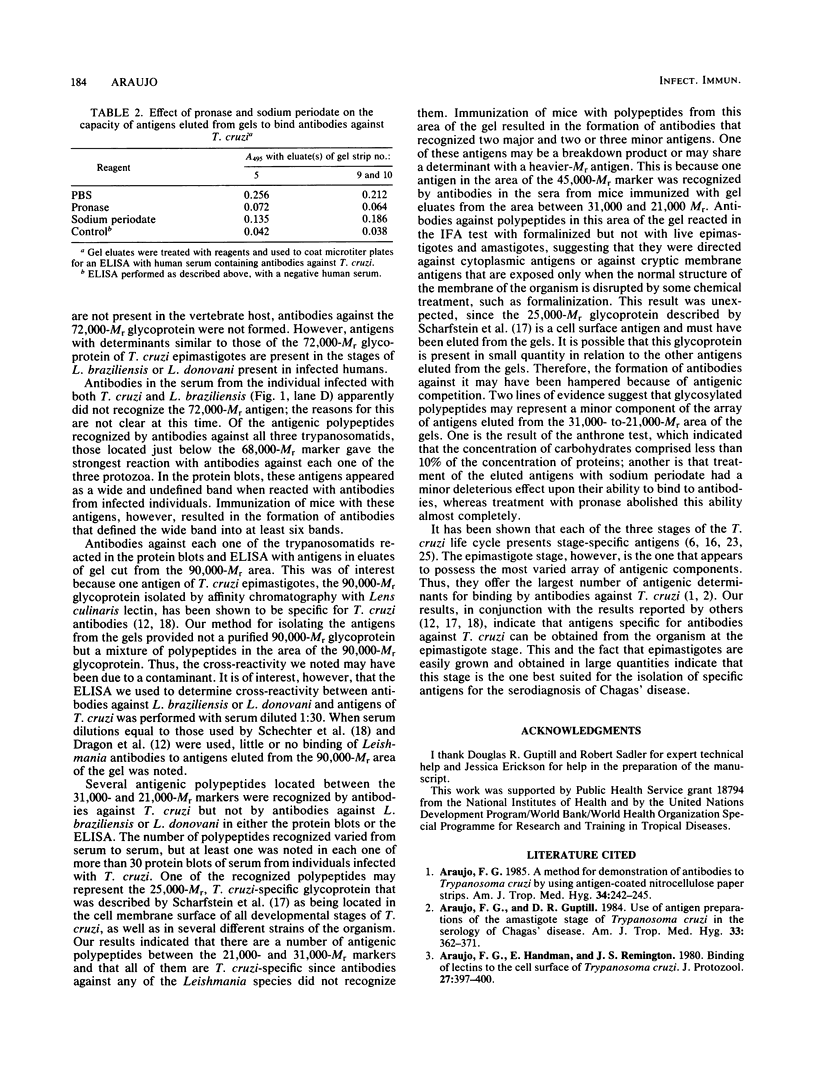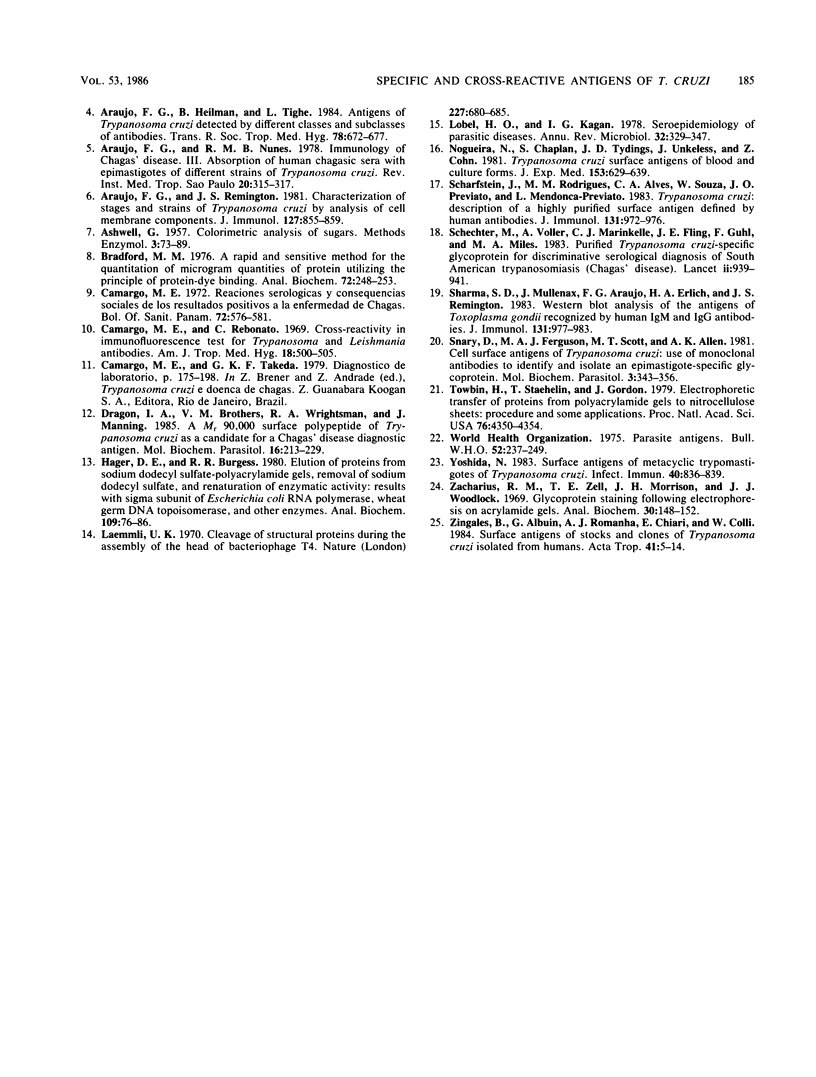Abstract
Antigens of the epimastigote stage of Trypanosoma cruzi were separated by sodium dodecyl sulfate-polyacrylamide gel electrophoresis under reducing conditions and examined for their ability to bind antibodies in sera from humans infected with this organism or infected with one or both of the related protozoa Leishmania braziliensis and Leishmania donovani by protein blot analysis and enzyme-linked immunosorbent assay. Most of the antigens were bound by antibodies against each one of the organisms. A group of antigens with Mrs between 31,000 and 21,000 were bound by antibodies against T. cruzi only. These antigens were isolated and used in an enzyme-linked immunosorbent assay for the differential diagnosis of Chagas' disease, with excellent results. All sera from individuals proven to be infected with T. cruzi reacted with the antigens, whereas none of the sera from individuals proven to be infected with L. braziliensis or L. donovani reacted with the antigens, even when tested at a low dilution. Biochemical characterization of the isolated antigens revealed the presence of protein and carbohydrate. The reactivity of the isolated antigens with antibodies was completely abolished by pronase and partially abolished by sodium periodate. Protein blot analysis of sera from mice immunized with the antigens revealed a major large band with an Mr between 31,000 and 21,000 and a minor band with an Mr of 45,000, suggesting sharing of epitopes between antigens of different Mrs. These sera did not agglutinate or lyse live epimastigotes. Indirect immunofluorescent antibody tests with live and dead epimastigotes revealed that antibodies in the sera only bound to Formalin-killed organisms.
Full text
PDF






Images in this article
Selected References
These references are in PubMed. This may not be the complete list of references from this article.
- Araujo F. G. A method for demonstration of antibodies to Trypanosoma cruzi by using antigen-coated nitrocellulose paper strips. Am J Trop Med Hyg. 1985 Mar;34(2):242–245. doi: 10.4269/ajtmh.1985.34.242. [DOI] [PubMed] [Google Scholar]
- Araujo F. G., Guptill D. Use of antigen preparations of the amastigote stage of Trypanosoma cruzi in the serology of Chagas' disease. Am J Trop Med Hyg. 1984 May;33(3):362–371. doi: 10.4269/ajtmh.1984.33.362. [DOI] [PubMed] [Google Scholar]
- Araujo F. G., Handman E., Remington J. S. Binding of lectins to the cell surface of Trypanosoma cruzi. J Protozool. 1980 Nov;27(4):397–400. doi: 10.1111/j.1550-7408.1980.tb05383.x. [DOI] [PubMed] [Google Scholar]
- Araujo F. G., Heilman B., Tighe L. Antigens of Trypanosoma cruzi detected by different classes and subclasses of antibodies. Trans R Soc Trop Med Hyg. 1984;78(5):672–677. doi: 10.1016/0035-9203(84)90237-2. [DOI] [PubMed] [Google Scholar]
- Araujo F. G., Nunes R. M. Immunology of Chagas' disease. III--Absorption of human chagasic sera with epimastigotes of different strains of Trypanosoma cruzi. Rev Inst Med Trop Sao Paulo. 1978 Nov-Dec;20(6):315–317. [PubMed] [Google Scholar]
- Araujo F. G., Remington J. S. Characterization of stages and strains of Trypanosoma cruzi by analysis of cell membrane components. J Immunol. 1981 Sep;127(3):855–859. [PubMed] [Google Scholar]
- Bradford M. M. A rapid and sensitive method for the quantitation of microgram quantities of protein utilizing the principle of protein-dye binding. Anal Biochem. 1976 May 7;72:248–254. doi: 10.1016/0003-2697(76)90527-3. [DOI] [PubMed] [Google Scholar]
- Camargo M. E. Reaccines serológicas consecuencias sociales de los resultados positivos a la enfermedad de Chagas. Bol Oficina Sanit Panam. 1972 Jun;72(6):576–582. [PubMed] [Google Scholar]
- Camargo M. E., Rebonato C. Cross-reactivity in fluorescence tests for Trypanosoma and Leishmania antibodies. A simple inhibition procedure to ensure specific results. Am J Trop Med Hyg. 1969 Jul;18(4):500–505. doi: 10.4269/ajtmh.1969.18.500. [DOI] [PubMed] [Google Scholar]
- Dragon E. A., Brothers V. M., Wrightsman R. A., Manning J. A Mr 90 000 surface polypeptide of Trypanosoma cruzi as a candidate for a Chagas' disease diagnostic antigen. Mol Biochem Parasitol. 1985 Sep;16(3):213–229. doi: 10.1016/0166-6851(85)90065-9. [DOI] [PubMed] [Google Scholar]
- Hager D. A., Burgess R. R. Elution of proteins from sodium dodecyl sulfate-polyacrylamide gels, removal of sodium dodecyl sulfate, and renaturation of enzymatic activity: results with sigma subunit of Escherichia coli RNA polymerase, wheat germ DNA topoisomerase, and other enzymes. Anal Biochem. 1980 Nov 15;109(1):76–86. doi: 10.1016/0003-2697(80)90013-5. [DOI] [PubMed] [Google Scholar]
- Laemmli U. K. Cleavage of structural proteins during the assembly of the head of bacteriophage T4. Nature. 1970 Aug 15;227(5259):680–685. doi: 10.1038/227680a0. [DOI] [PubMed] [Google Scholar]
- Lobel H. O., Kagan I. G. Seroepidemiology of parasitic diseases. Annu Rev Microbiol. 1978;32:329–347. doi: 10.1146/annurev.mi.32.100178.001553. [DOI] [PubMed] [Google Scholar]
- Nogueira N., Chaplan S., Tydings J. D., Unkeless J., Cohn Z. Trypanosoma cruzi. Surface antigens of blood and culture forms. J Exp Med. 1981 Mar 1;153(3):629–639. doi: 10.1084/jem.153.3.629. [DOI] [PMC free article] [PubMed] [Google Scholar]
- Scharfstein J., Rodrigues M. M., Alves C. A., de Souza W., Previato J. O., Mendonça-Previato L. Trypanosoma cruzi: description of a highly purified surface antigen defined by human antibodies. J Immunol. 1983 Aug;131(2):972–976. [PubMed] [Google Scholar]
- Schechter M., Flint J. E., Voller A., Guhl F., Marinkelle C. J., Miles M. A. Purified Trypanosoma cruzi specific glycoprotein for discriminative serological diagnosis of South American trypanosomiasis (Chagas' disease). Lancet. 1983 Oct 22;2(8356):939–941. doi: 10.1016/s0140-6736(83)90453-1. [DOI] [PubMed] [Google Scholar]
- Sharma S. D., Mullenax J., Araujo F. G., Erlich H. A., Remington J. S. Western Blot analysis of the antigens of Toxoplasma gondii recognized by human IgM and IgG antibodies. J Immunol. 1983 Aug;131(2):977–983. [PubMed] [Google Scholar]
- Snary D., Ferguson M. A., Scott M. T., Allen A. K. Cell surface antigens of Trypanosoma cruzi: use of monoclonal antibodies to identify and isolate an epimastigote specific glycoprotein. Mol Biochem Parasitol. 1981 Oct;3(6):343–356. doi: 10.1016/0166-6851(81)90035-9. [DOI] [PubMed] [Google Scholar]
- Towbin H., Staehelin T., Gordon J. Electrophoretic transfer of proteins from polyacrylamide gels to nitrocellulose sheets: procedure and some applications. Proc Natl Acad Sci U S A. 1979 Sep;76(9):4350–4354. doi: 10.1073/pnas.76.9.4350. [DOI] [PMC free article] [PubMed] [Google Scholar]
- Yoshida N. Surface antigens of metacyclic trypomastigotes of Trypanosoma cruzi. Infect Immun. 1983 May;40(2):836–839. doi: 10.1128/iai.40.2.836-839.1983. [DOI] [PMC free article] [PubMed] [Google Scholar]
- Zacharius R. M., Zell T. E., Morrison J. H., Woodlock J. J. Glycoprotein staining following electrophoresis on acrylamide gels. Anal Biochem. 1969 Jul;30(1):148–152. doi: 10.1016/0003-2697(69)90383-2. [DOI] [PubMed] [Google Scholar]
- Zingales B., Abuin G., Romanha A. J., Chiari E., Colli W. Surface antigens of stocks and clones of Trypanosoma cruzi isolated from humans. Acta Trop. 1984 Mar;41(1):5–16. [PubMed] [Google Scholar]





